Crab rangoon is a popular appetizer that is loved by many. But have you ever wondered about its nutritional value? In this article, I will take you on a journey through the world of crab rangoon nutrition information, exploring its ingredients, analyzing its calorie and macronutrient content, and uncovering its potential health benefits. We will also discuss the risks of consuming high amounts of saturated fat found in crab rangoon and explore how making it at home can affect its nutritional value. So, let’s dive in and discover the delicious and nutritious side of crab rangoon!
Key Takeaways:
- Crab rangoon is a popular appetizer filled with lump meat crab and cream cheese.
- A 100-gram serving of frozen crab rangoon contains 303 calories, 36.4 grams of carbohydrates, 9.09 grams of protein, and 14.1 grams of fat.
- Crab rangoon has a high sodium content, with the Target brand containing 687 milligrams and the Harris Teeter brand containing 447 grams of sodium per serving.
- Consuming too much saturated fat can lead to cardiovascular issues, so it’s important to limit your intake of crab rangoon.
- On the positive side, crab rangoon is a good source of calcium, providing around 4 percent of the recommended daily dose per serving.
Understanding the Ingredients
Let’s take a closer look at the ingredients that make up this delectable treat. Crab rangoon, a popular appetizer commonly served in Chinese American restaurants, is made with a combination of flavorful ingredients. The star of the show is crab meat, which is mixed with cream cheese to create a creamy and indulgent filling. This savory mixture is then wrapped in a delicate wonton wrapper and deep-fried to perfection. The result is a crispy and flavorful appetizer that is hard to resist.
In addition to crab meat and cream cheese, other ingredients are often added to enhance the taste of crab rangoon. Green onions, garlic, and Worcestershire sauce are commonly included to add a hint of tanginess and depth of flavor. These components work together to create a balance of flavors that make crab rangoon a favorite among many.
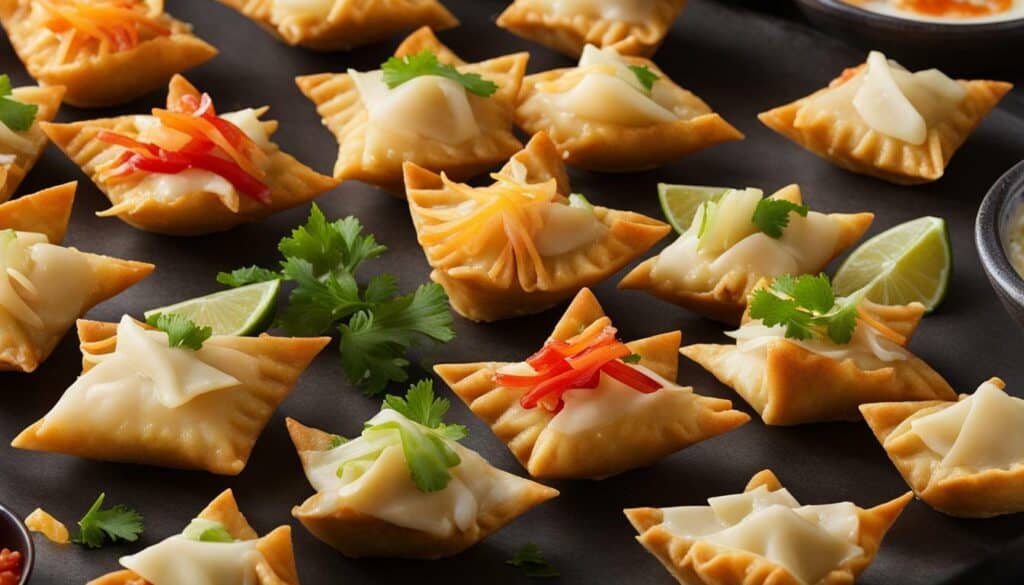
While crab rangoon is undeniably delicious, it’s important to note that it may not be the healthiest option. As mentioned earlier, a 100-gram serving of frozen crab rangoon contains 303 calories and 14.1 grams of fat. With its deep-fried preparation, it is no surprise that crab rangoon is not a low-calorie appetizer. However, it can still be enjoyed in moderation as part of a balanced diet. Pairing it with a side of steamed vegetables or opting for a smaller portion can help keep your calorie intake in check.
In summary, crab rangoon is a tantalizing mix of crab meat, cream cheese, and various seasonings. While it may not be the healthiest option due to its calorie and fat content, it can still be enjoyed in moderation. So go ahead and indulge in this tasty appetizer, but remember to balance it out with healthier choices throughout the day.
Crab Rangoon Calories and Macronutrients
Discover how many calories and macronutrients you can expect to find in a serving of crab rangoon. This popular appetizer, commonly served in Chinese American restaurants, consists of deep-fried wontons filled with lump meat crab and cream cheese. Indulging in this delicious dish is a treat, but it’s important to be mindful of its nutritional content.
According to the USDA, a 100-gram serving of frozen crab rangoon contains approximately 303 calories. In terms of macronutrients, it provides 36.4 grams of carbohydrates, 9.09 grams of protein, and 14.1 grams of fat. It’s worth noting that crab rangoon can be quite high in sodium, with brands like Target and Harris Teeter containing 687 milligrams and 447 milligrams of sodium per serving, respectively.
To put these numbers into perspective, it’s important to consider your overall dietary goals. The high calorie and fat content in crab rangoon may not align with a low-calorie or low-fat diet. Additionally, excessive consumption of saturated fat, which can be found in this appetizer, can increase your risk of cardiovascular issues.
However, there is a silver lining. Crab rangoon offers a decent amount of calcium, providing around 4 percent of the recommended daily intake per serving. Calcium is essential for maintaining strong bones and teeth.
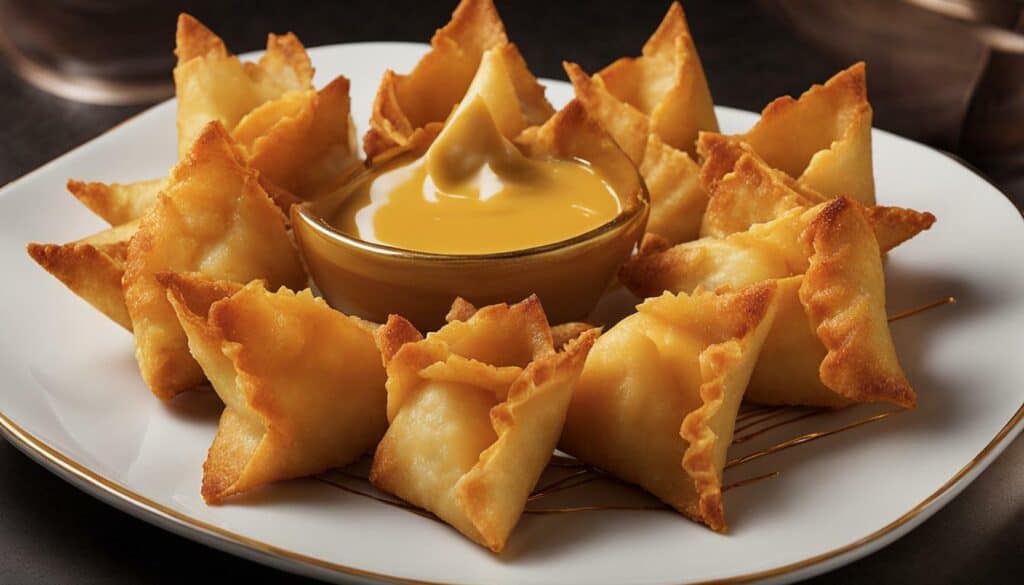
Keep in mind that moderation is key when enjoying this tasty appetizer. While it may not be the healthiest option, treating yourself to crab rangoon every now and then can be a delightful indulgence. As with any food, it’s always a good idea to be mindful of portion sizes and make balanced choices overall.
Analyzing the Nutritional Facts
Let’s break down the nutritional facts to get a better understanding of what you’re consuming. Crab rangoon is a popular appetizer that combines the flavors of lump meat crab and cream cheese, wrapped in a deep-fried wonton. While it may be delicious, it’s important to be mindful of its nutritional value. According to the USDA, a 100-gram serving of frozen crab rangoon contains 303 calories, 36.4 grams of carbohydrates, 9.09 grams of protein, and 14.1 grams of fat.
One thing to note is the high sodium content found in crab rangoon. The Target brand contains 687 milligrams of sodium, while the Harris Teeter brand contains 447 milligrams per serving. This is a significant amount considering the recommended daily limit for sodium intake is around 2,300 milligrams. Therefore, it’s advisable to enjoy crab rangoon in moderation and consider alternatives if you’re watching your sodium intake.
| Nutrient | Amount per 100g |
|---|---|
| Calories | 303 |
| Carbohydrates | 36.4g |
| Protein | 9.09g |
| Fat | 14.1g |
| Sodium | 687mg (Target), 447mg (Harris Teeter) |
On the positive side, crab rangoon can be a good source of calcium, providing approximately 4% of the recommended daily intake per serving. Calcium is essential for maintaining strong bones and teeth, as well as supporting various bodily functions. However, it’s important to note that the nutritional value may vary depending on the brand and preparation method. Making crab rangoon at home allows you to have more control over the ingredients and portion sizes, which can be beneficial for those concerned about their nutritional intake.

Overall, while crab rangoon can be a tasty treat, it’s crucial to consume it in moderation due to its high saturated fat content. Consuming too much saturated fat can increase the risk of cardiovascular issues. By being aware of the nutritional facts and making informed choices, you can still enjoy this appetizer while maintaining a balanced diet. Remember, moderation and mindful eating are key to a healthy lifestyle.
The Risks of High Saturated Fat
Find out why it’s important to be mindful of your saturated fat intake when enjoying this appetizer.
When it comes to crab rangoon, one of the main concerns is its high saturated fat content. Consuming too much saturated fat can have negative effects on our health, particularly on our cardiovascular system. The American Heart Association recommends limiting saturated fat intake to less than 13 grams per day for a 2,000-calorie diet.
Saturated fat is known to raise LDL cholesterol levels, which is the “bad” cholesterol. High levels of LDL cholesterol can clog the arteries, leading to an increased risk of heart disease, stroke, and other cardiovascular issues. It’s crucial to be mindful of your saturated fat intake and make healthier choices to protect your heart.
While crab rangoon can be delicious and satisfying, it’s best to enjoy it in moderation. Consider opting for low-calorie alternatives or making homemade versions with healthier ingredients. By reducing the saturated fat content and adding more nutritious elements, you can still enjoy the flavors of crab rangoon while making a healthier choice for your overall well-being.
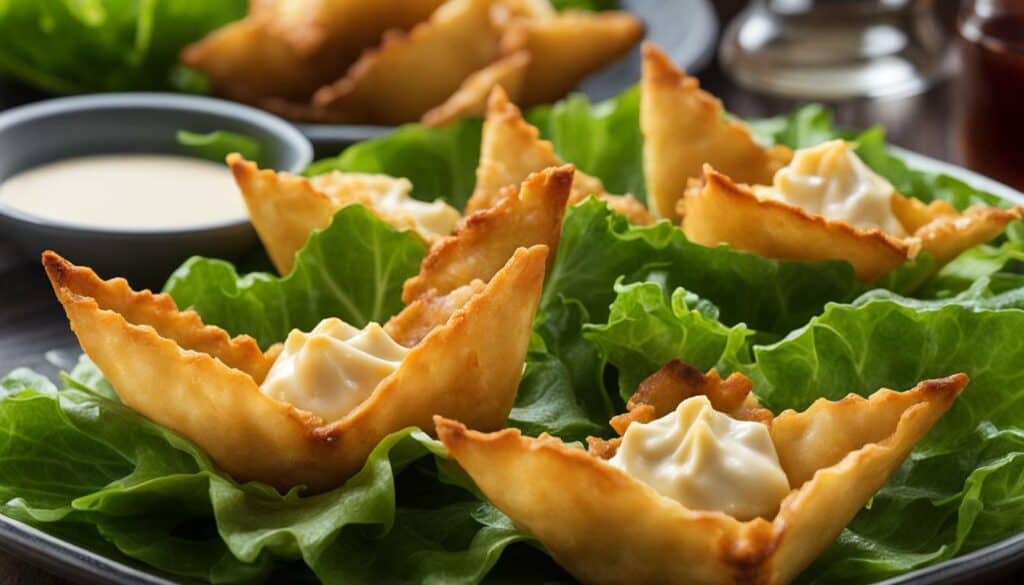
“Moderation is key when it comes to indulging in this tasty appetizer.”
A well-balanced diet is essential for maintaining good health, and that includes being aware of the nutritional content of the foods we consume. While crab rangoon may be a tempting treat, it’s important to keep in mind the risks associated with its high saturated fat content. By practicing moderation and making informed choices, you can still enjoy this appetizer while keeping your heart health in check.
Health Benefits of Crab Rangoon
Despite its indulgent flavors, crab rangoon does have some health benefits worth noting. The combination of lump crab meat and cream cheese brings a unique mix of nutrients to this popular appetizer. Let’s explore the potential health benefits that crab rangoon can offer:
- Protein Boost: Crab rangoon contains a decent amount of protein, with approximately 9.09 grams per 100-gram serving. Protein is an essential nutrient that plays a crucial role in building and repairing tissues, supporting immune function, and providing energy. Including protein-rich foods like crab rangoon in your diet can help meet your body’s protein needs.
- Calcium Source: Incorporating crab rangoon into your meal plan can also contribute to your calcium intake. Calcium is essential for strong bones and teeth, as well as for optimal nerve and muscle function. A serving of crab rangoon provides around 4 percent of the recommended daily dose of calcium, making it a small but valuable source of this vital mineral.
- Omega-3 Fatty Acids: While crab rangoon is not particularly high in omega-3 fatty acids, the lump crab meat used in this appetizer does contain some. Omega-3 fatty acids are healthy fats that are known for their anti-inflammatory properties and their role in heart health. Including seafood like crab rangoon as part of a balanced diet can contribute to overall omega-3 intake.
“Incorporating crab rangoon into your meal plan can contribute to your calcium intake and provide a protein boost.”
It is important to note that while crab rangoon offers these potential health benefits, moderation is key. Due to its high saturated fat content, consuming too much crab rangoon can increase the risk of cardiovascular issues. To enjoy the flavors and benefits of crab rangoon while maintaining a balanced diet, consider homemade versions with healthier ingredients and smaller portion sizes.
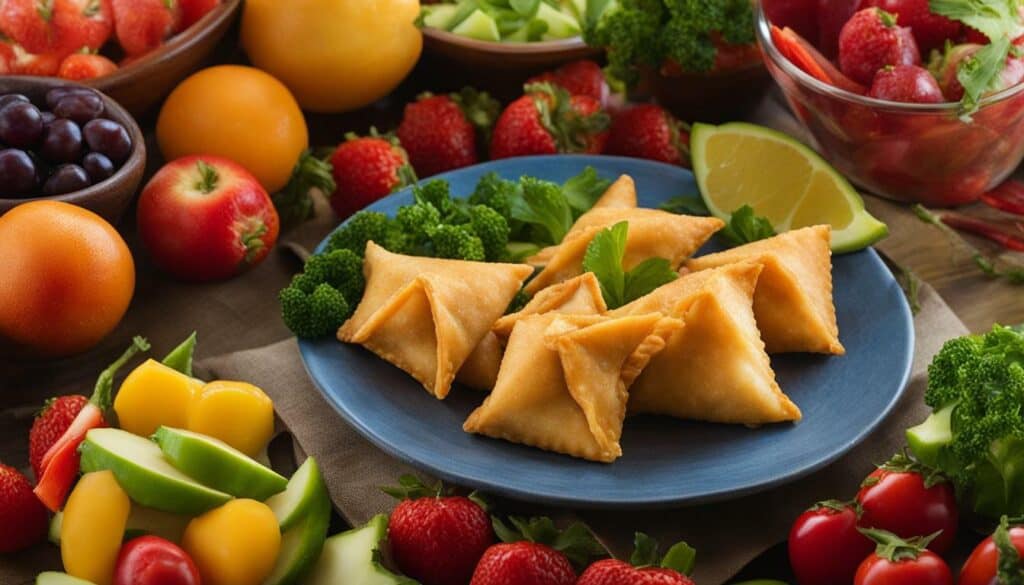
Crab Rangoon Nutrition Facts
Now that you’re aware of the health benefits and nutritional facts of crab rangoon, you can make informed choices about including this appetizer in your diet. Remember to enjoy it in moderation and consider homemade versions with healthier ingredients for a balanced indulgence.
Homemade Crab Rangoon Nutrition
Discover how homemade crab rangoon compares to the versions found in restaurants in terms of nutrition. Making crab rangoon at home gives you more control over the ingredients and cooking methods, which can affect its nutritional value.
When preparing crab rangoon from scratch, you can choose leaner ingredients and reduce the amount of oil used for frying. This can help lower the overall calorie and fat content of the dish. Additionally, you can experiment with different types of cream cheese, opting for low-fat or even dairy-free alternatives.
One advantage of homemade crab rangoon is that you can easily adjust the amount of seasoning and salt used in the filling. This allows you to reduce the sodium content, which is typically high in restaurant versions. By using less salt or opting for low-sodium ingredients, you can enjoy a healthier homemade crab rangoon without compromising on taste.
| Nutrient | Homemade Crab Rangoon (per serving) | Restaurant Crab Rangoon (per serving) |
|---|---|---|
| Calories | 240 | 303 |
| Carbohydrates (g) | 23 | 36.4 |
| Protein (g) | 8 | 9.09 |
| Fat (g) | 12 | 14.1 |
| Sodium (mg) | 350 | 447-687 |
It’s important to note that these values are approximate and can vary based on the specific ingredients and cooking methods used. However, by making crab rangoon at home, you have the opportunity to make healthier choices and create a version that aligns with your dietary preferences and needs.
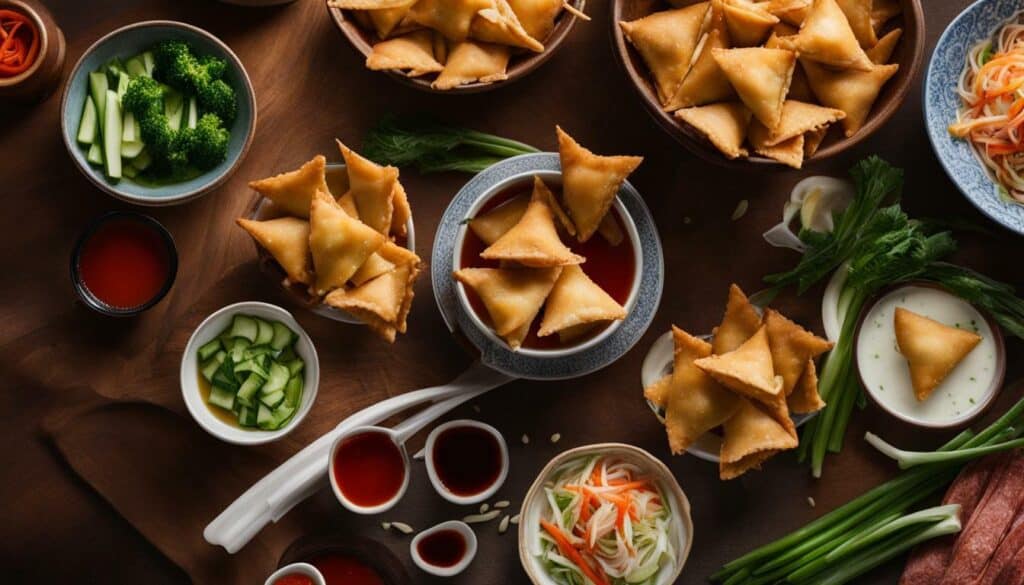
In conclusion, homemade crab rangoon can be a healthier alternative to the restaurant versions. By selecting leaner ingredients, controlling the seasoning, and reducing sodium intake, you can enjoy this delicious appetizer with fewer calories and less fat. Remember to exercise moderation and enjoy crab rangoon as part of a balanced diet.
The Importance of Moderation
Learn why moderation is key to enjoying this delicious appetizer without compromising your health.
Crab Rangoon, a popular appetizer commonly served in Chinese American restaurants, is a deep-fried wonton filled with lump meat crab and cream cheese. While it may be tempting to indulge in this flavorful dish, it is important to be mindful of your consumption due to its high saturated fat content. Consuming too much saturated fat can lead to cardiovascular issues, making it essential to practice moderation when enjoying crab rangoon.
According to the USDA, a 100-gram serving of frozen crab rangoon contains 303 calories, 36.4 grams of carbohydrates, 9.09 grams of protein, and 14.1 grams of fat. Additionally, it has a high sodium content, with some brands containing as much as 687 milligrams per serving. However, it does offer some health benefits, as it is a good source of calcium, providing around 4 percent of the recommended daily dose per serving.
To maintain a balanced diet, it is important to be mindful of your overall calorie and nutrient intake. Enjoying crab rangoon in moderation can be a part of a healthy diet, but it is recommended to pair it with nutritious foods that are lower in saturated fat and higher in essential nutrients. By monitoring your portion sizes and incorporating a variety of foods into your meals, you can savor the flavors of crab rangoon without compromising your health.
| Nutrient | Amount per Serving |
|---|---|
| Calories | 303 |
| Carbohydrates | 36.4g |
| Protein | 9.09g |
| Fat | 14.1g |
| Sodium | 687mg (Brand A) |
Remember, enjoying crab rangoon in moderation can be a delicious and satisfying treat. By being mindful of your consumption and incorporating it into a balanced diet, you can enjoy this appetizer without compromising your health.
Calcium Content in Crab Rangoon
Did you know that crab rangoon can be a source of calcium? Let’s explore more about its nutritional value. Calcium is an essential mineral that plays a crucial role in maintaining strong bones and teeth. It also supports proper nerve function and muscle contractions.
When we talk about the calcium content in crab rangoon, it’s important to note that the exact amount may vary depending on the recipe and brand. However, a typical serving of crab rangoon can provide around 4 percent of the recommended daily dose of calcium. This may not seem like much, but every bit counts towards meeting your daily calcium needs.
To give you a better idea, let’s take a look at the nutritional value of a 100-gram serving of frozen crab rangoon. According to the USDA, this serving contains 303 calories, 36.4 grams of carbohydrates, 9.09 grams of protein, and 14.1 grams of fat. It’s worth mentioning that crab rangoon also has a high sodium content, with some brands containing around 687 milligrams per serving. So, it’s important to enjoy it in moderation.
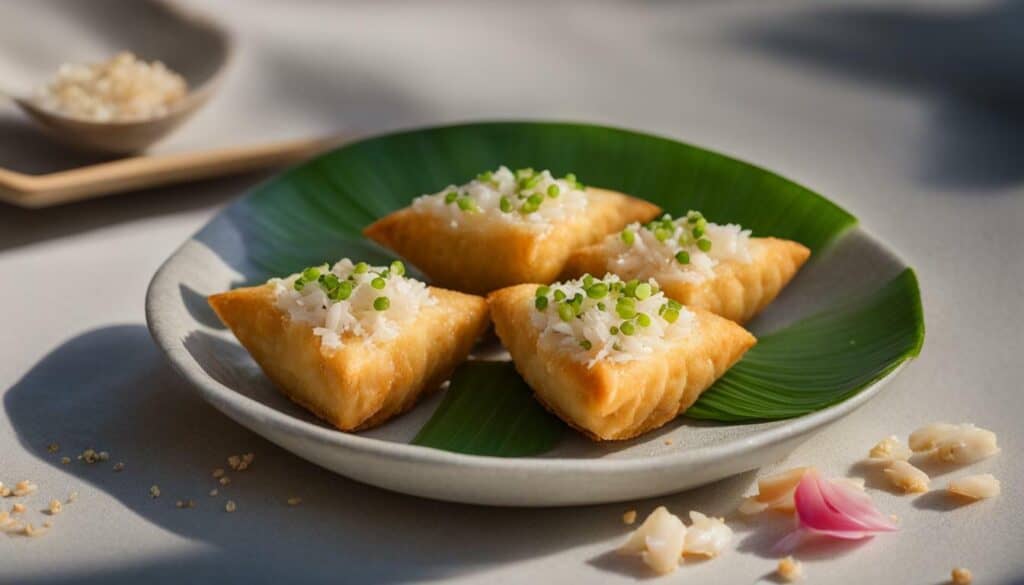
While crab rangoon can be a tasty treat, it’s important to remember to enjoy it in moderation due to its high saturated fat content. Consuming too much saturated fat can increase your risk of cardiovascular issues. So, savor the flavors of crab rangoon, but be mindful of your overall dietary choices for a balanced lifestyle.
Recipe Analysis and Tips
If you’re looking to enjoy crab rangoon while keeping an eye on your health, we have some recipe analysis and tips for you. This popular appetizer can be a delicious addition to any meal, but it’s important to consider its nutritional profile. By making a few tweaks to the traditional recipe, you can create a lighter and more nutritious version of this indulgent treat.
Recipe Analysis
Let’s start by breaking down the traditional crab rangoon ingredients and their impact on the dish’s nutritional value. The key components of crab rangoon include lump meat crab, cream cheese, and wonton wrappers. While crab provides a good source of protein, cream cheese can be high in saturated fat and calories. By reducing the amount of cream cheese or opting for a lighter version, you can significantly cut down on the fat content of your crab rangoon.
Another way to make your crab rangoon healthier is by choosing a baking method instead of deep-frying. Baking the wontons in the oven can help reduce the overall calorie and fat content while still achieving a crispy texture. Additionally, consider using whole wheat or gluten-free wonton wrappers for a healthier alternative.
Helpful Tips
Here are some additional tips to make your crab rangoon even more nutritious:
- Use fresh and high-quality lump meat crab for the best flavor and nutritional value.
- Add some finely chopped vegetables like bell peppers or scallions to increase the fiber and vitamin content.
- Season your filling with herbs and spices instead of relying on excessive salt or sodium-filled sauces.
- Serve your crab rangoon with a side of mixed greens or a light salad to add more vitamins and minerals to your meal.
Remember, moderation is key when enjoying crab rangoon. While it can be a tasty treat, it’s important to balance it with a well-rounded and nutritious diet. By making small changes to the traditional recipe and incorporating healthier ingredients, you can still enjoy the flavors of crab rangoon while keeping your health goals in mind.
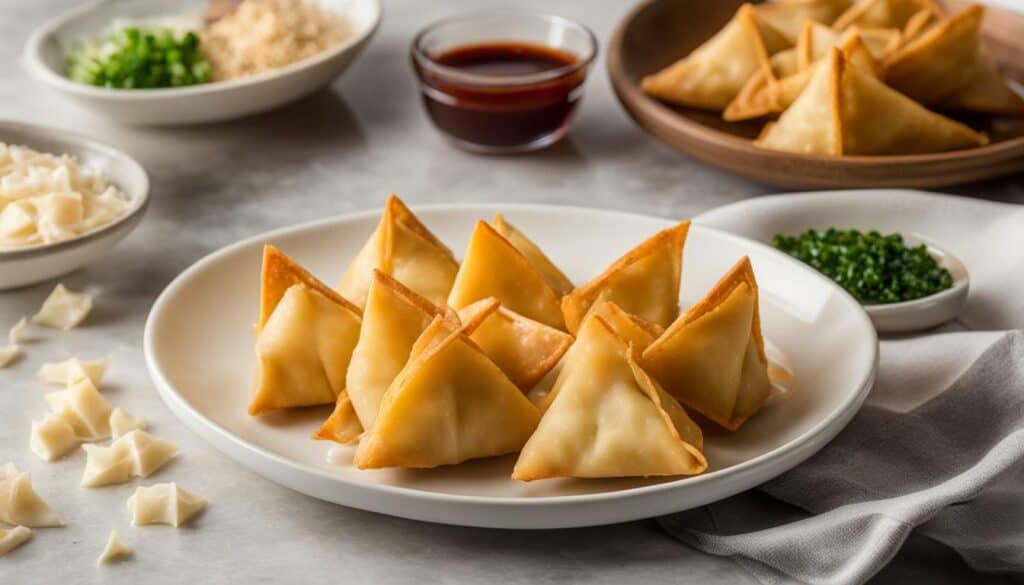
Crab rangoon is undoubtedly a tasty treat, but it’s essential to be aware of its nutritional information and enjoy it in moderation. A 100-gram serving of frozen crab rangoon contains 303 calories, 36.4 grams of carbohydrates, 9.09 grams of protein, and 14.1 grams of fat. It also has a high sodium content, with the Target brand containing 687 milligrams and the Harris Teeter brand containing 447 grams of sodium per serving.
While crab rangoon can be a flavorful appetizer, it’s important to limit our intake due to its high saturated fat content. Consuming too much saturated fat can lead to cardiovascular issues, so moderation is key. However, there are some positive aspects to consider. Crab rangoon is a good source of calcium, providing around 4 percent of the recommended daily dose per serving.
For those looking to make healthier choices, homemade crab rangoon can offer a more controlled nutritional value. By choosing alternative cooking methods and using reduced-fat cream cheese, it’s possible to reduce the calorie and fat content without compromising flavor.
In conclusion, enjoying crab rangoon can be a delightful experience, but it’s important to be mindful of its nutritional profile. By understanding the ingredients and making informed choices, we can still savor this appetizer while maintaining a balanced diet.
FAQ
Q: How many calories are in a serving of crab rangoon?
A: A 100-gram serving of frozen crab rangoon contains 303 calories.
Q: What are the macronutrient values in crab rangoon?
A: A 100-gram serving of crab rangoon contains 36.4 grams of carbohydrates, 9.09 grams of protein, and 14.1 grams of fat.
Q: Is crab rangoon high in sodium?
A: Yes, crab rangoon has a high sodium content. The Target brand contains 687 milligrams of sodium per serving, while the Harris Teeter brand contains 447 milligrams.
Q: Why should I limit my intake of crab rangoon?
A: Crab rangoon is high in saturated fat, which can lead to cardiovascular issues if consumed in excess.
Q: Are there any health benefits to eating crab rangoon?
A: While moderation is key, crab rangoon does provide a good source of calcium, providing around 4 percent of the recommended daily dose per serving.
Q: How can I make crab rangoon healthier at home?
A: You can make crab rangoon healthier by using less cream cheese and opting for baking instead of deep-frying.
Q: What is the importance of moderation when consuming crab rangoon?
A: It is important to consume crab rangoon in moderation due to its high saturated fat content.
Q: Can you provide a recipe analysis for crab rangoon?
A: Sure! A recipe analysis for crab rangoon will be provided in the Recipe Analysis and Tips section of this article.
What Are the Nutritional Benefits of Injera?
Unveiling the health benefits of injera: Injera, a traditional Ethiopian flatbread made with fermented teff flour, offers a range of nutritional benefits. Packed with iron, calcium, and dietary fiber, injera aids in maintaining healthy bones and digestion. This gluten-free food is also rich in vitamins B and C, which boost immune function and promote overall well-being.

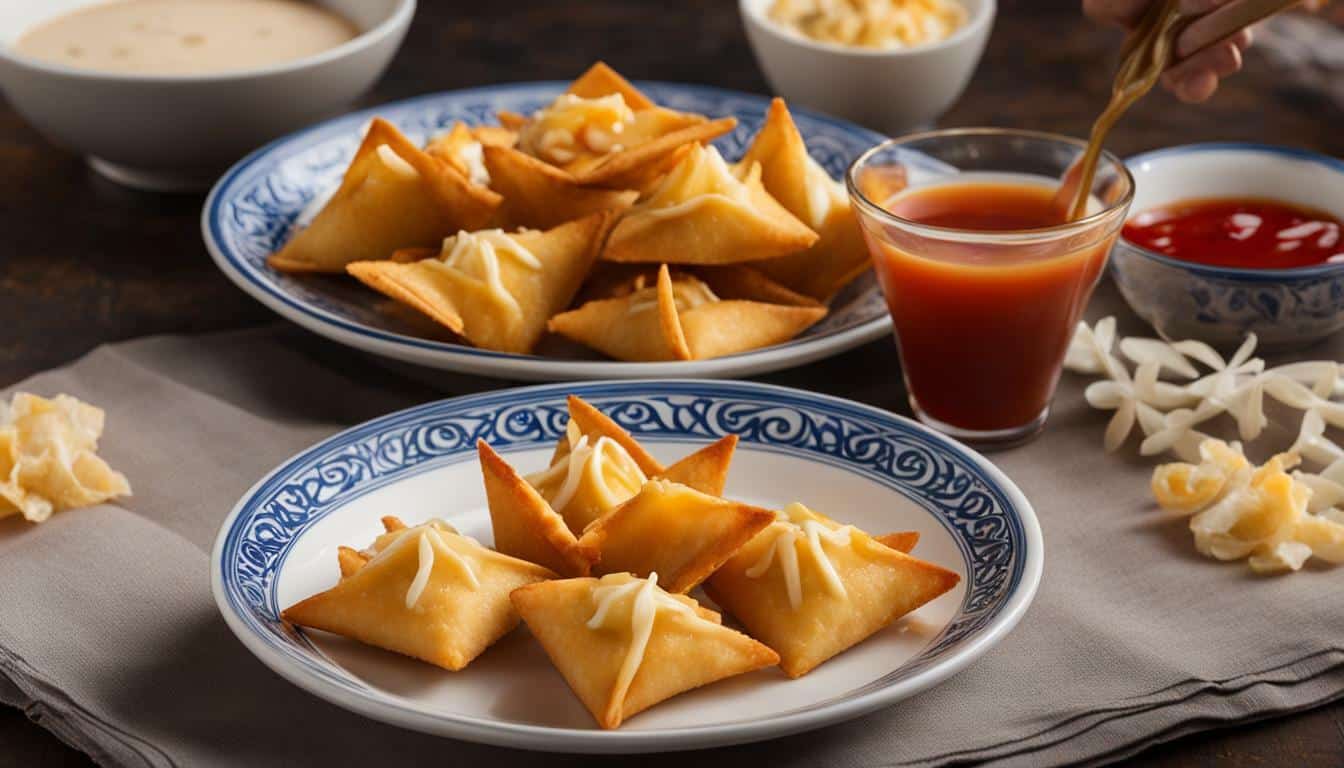



Leave a Reply